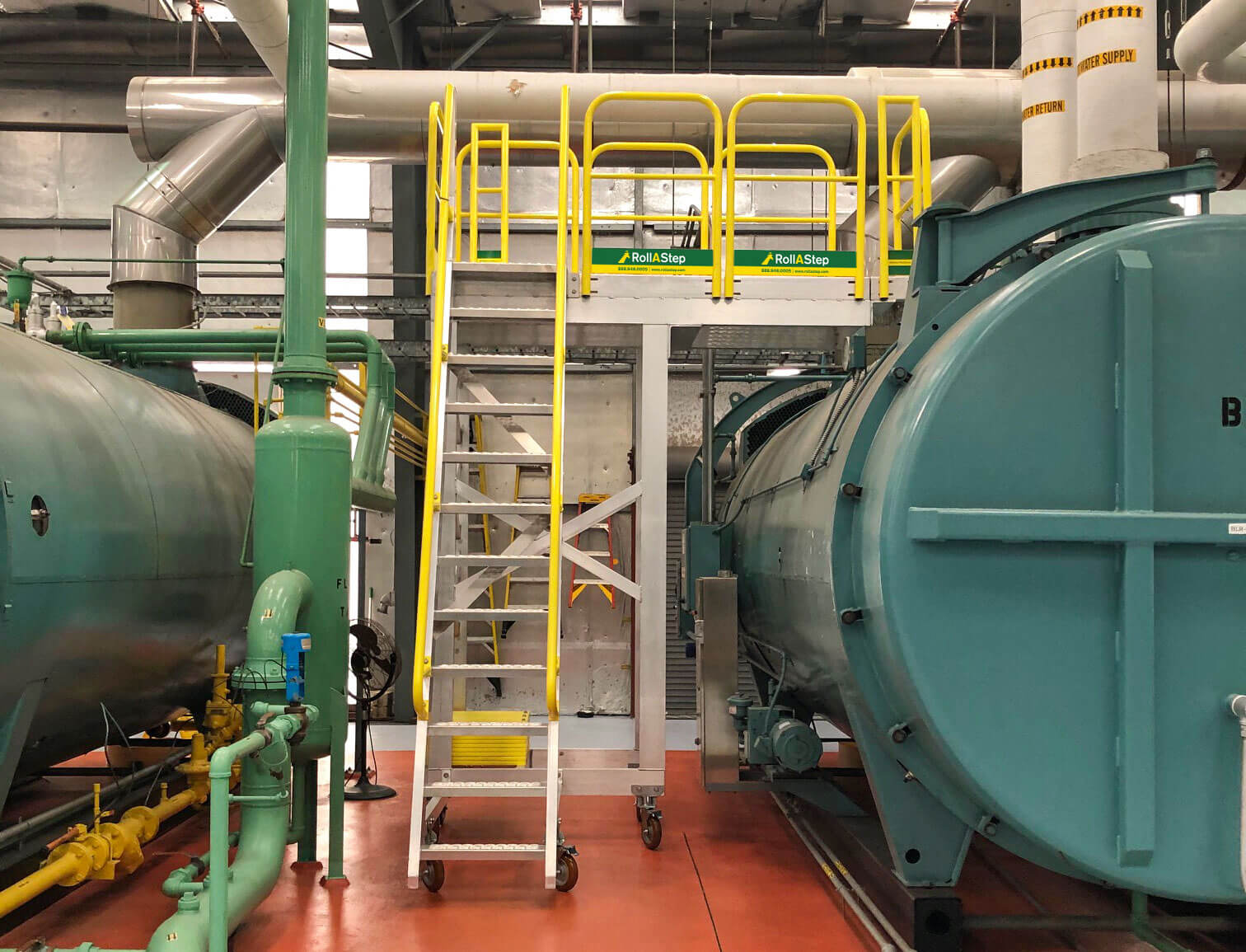Get a quote, configure a custom stair or ask a question. We're here to help!
Boiler Room Dilemma Solved with Mobile Work Platform
View All Rolling Stairs InstallationsCantilever mobile work platform installation for a boiler room
Without boilers, engines wouldn’t be able to create the steam that turns generators. Boilers are large tanks where water is turned into steam, which powers turbines that produce electricity. Also called steam generators, boiler systems are necessary for power generation because they depend on other fuels such as coal, natural gas, or nuclear power to heat water into vapor needed to turn the turbines.
In essence, boilers come down to one thing: water must be boiled, heated, or vaporized in approaches used to raise a fluid’s temperature (typically water) in a sealed chamber. The electricity produced may subsequently use the result for various thermal applications: food preparation, temperature control, hygiene, heating systems, and boiler-based power production.
Boiler systems come in different sizes, depending on the amount of steam they need to produce. Small boilers can generate enough steam to power a small engine, while large boilers are required to create enough vapors for a power plant. Some generators powering our homes and businesses would not function without boilers — that’s why they’re essential in ensuring that we have electricity! Where large equipment worsened by temperature swings is concerned, metal stairs are there to the rescue! Portable metal ladders offer an easier and faster way to get large equipment up off your feet and can withstand temperature fluctuations much better than their counterparts.
Boiler rooms are often found in factories, power plants, and other industrial settings where there is a need for large amounts of power requirements. The closed and cramped quarters make it difficult for workers to stay cool, and the heat can be overwhelming. Additionally, the noise level in a boiler room is often very loud, making it difficult to communicate.
Worker safety is the least of your concern when dealing with boilers. Inside the boiler itself, four possible catastrophic scenarios can occur:
- Total Meltdown: Meltdowns happen because the hot metal rods inside the boiler have surpassed their melting point. It is caused by the boiler running on very low water pressure. Although it might not trigger an explosion by itself, it will severely damage the boiler to reach a potentially highly volatile state.
- Heat Blast: This is a circumstance in which the heating surfaces get overheated due to a lack of water, and cooler water is introduced. When the water suddenly turns to steam, it expands by 1,600 times its original volume, resulting in an explosion since the vapors have nowhere to go.
- Blow Up by Ignition: These can occur due to gases accumulating and activated by a small spark or ignition. This danger can happen inside and outside the boiler, and safety mechanisms are in place to prevent these situations, which we will go through in the next slides.
- Vapor Pressure: Excessive steam buildup exceeds the vessel’s design pressures. There are other safeguards in place to avoid this.
Working in a boiler room is not for the faint of heart. The environment is cramped and hot, and the constant threat of being scalded by steam or contact with the equipment. Despite these dangers, boiler room workers must be able to move around quickly and efficiently to do their job. To achieve this balance, boiler room workers must receive extensive safety training and be constantly aware of their surroundings. Even with these precautions, accidents can still happen, so boiler room workers need to have quick reflexes and be able to think on their feet. Boiler room workers can ensure their safety and avoid potential disasters by maintaining a high level of vigilance.

For instance, Rollastep’s DCO boiler project saved the company a lot of money by providing custom access solutions to their extra large boilers. They ordered custom-fabricated catwalks and rolling ladder platforms for boiler room workers to reach control valves blocked by hot boiler vessels in a cramped space.
Working in a boiler room can be extremely dangerous if the proper safety protocols are ignored. Many potential hazards exist in the energy industry, such as high temperatures, exposure to poisonous gases, and the possibility of explosion. Some ways workers can stay safe include wearing proper clothing, using safety equipment, and following all safety procedures. By accepting these precautions, boiler room workers can help to prevent accidents and injuries.
The dangers of working in a boiler room are real, but facilities can minimize them by implementing the right safety measures. Boiler room workers need to be aware of the risks and take steps to protect themselves. By abiding by these precautions, boiler room workers can help to thwart accidents and injuries.










